Yesterday was a long, fulfilling day out on the town with my cousin, Dong Woo. Our first priority was to learn how to use public transport. In Seoul, you can pay for public transport with cash, or with rechargeable cards. The cards utilize RFID tags, so all you have to do is hold them up to a sensor. Every bus, subway train, and taxi has a reader for this type of card. Not only do you get discounts for using the card, but if you switch modes of transport (i.e. from subway to bus), within 20 minutes of a swipe the next swipe is free.

This is the RFID card I bought to pay for transport.
We got on the bus in Apgujeong-dong, and rode all the way to the dedicated bus stop for Korea University. Conveniently, the business school is directly across the street from the bus stop, and directly above a dedicated subway station. The subway doesn’t go directly to my cousin’s place, but you can switch lines at Yaksu station to reach Apgujeong.

Somehow this is the only picture that saved for Korea University. This is part of the business school’s main hall, and the awning in the bottom right of the picture covers the subway station entrance.
Rather than return home, we took a taxi to visit Gyeongbokgung Palace. I know very little Korean history, so it was very enjoyable walking through the Folk Museum and learning about the development of Korean culture.

Large pagoda-style temple houses a Buddha within. First stop after entering the palace grounds.
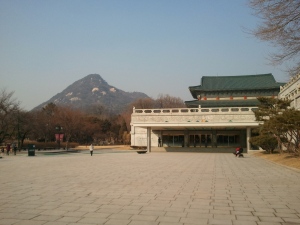
Entrance to the folk museum which is housed beneath the temple.

Ancient Korean star chart, complete with astrological relationships.

Ancient Korean Confucian text.
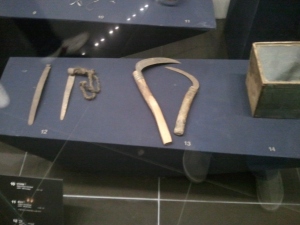
Ancient Kama, used for rice harvesting and in martial arts.

The Blue House, where the current President of the Republic of Korea maintains his residence.

More traditional buildings maintained on the palace grounds.

More traditional buildings on the grounds.
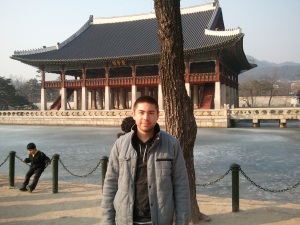
The King’s entertainment house. The royal family would also take leisurely rides in a boat in this man-made pond.
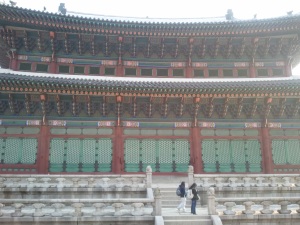
Rear of the King’s main reception hall. Very large structure.

Me standing in front of the reception hall. Its size is quite humbling.

King’s throne and reception hall interior. Very spartan for a king, likely due to Confucian ideals.

Amazingly unique architecture and design within. Reminds me of an amalgamation of Meso-American and Confucian Chinese.

This picture captures all that is Seoul at once: past, present, and future coexist in harmony. The palace serves to remind Korea of its rich cultural history, the city lies just outside and stands testament to modernity. Construction is ever-present, symbolizing Korea’s striving desire to progress.
After exiting the palace grounds from the main gate, we came upon the “Main Street” of Seoul. Most important administrative buildings are located along its wide streets, facing a central rectangular plaza. Beneath the plaza is the YiSunShin museum, which tells the story of the general who built the palace grounds and the gates.
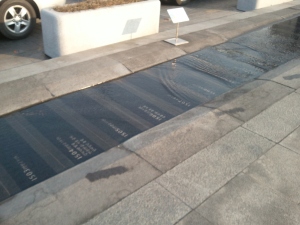
This false creek runs the length of the road. Tiles beneath the clear water document Korea’s long history.
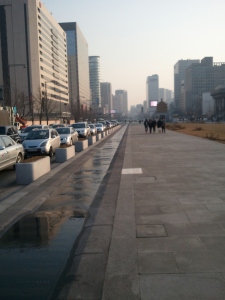
Another view of the creek of Korean history.
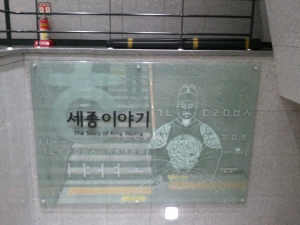
Entrance to the YiSunShin museum.

Depiction of a turtle boat. These boats were extremely useful in defending against the Japanese, whose soldiers were extremely adept at close-quarters combat. The turtle boat could keep soldiers at a distance to be dispatched by the more advanced Korean cannon and rifles.
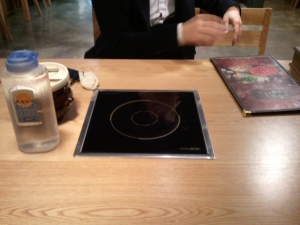
Within the museum we stopped for ShabuShabu, a Japanese dish. You sit around a table with an induction range.
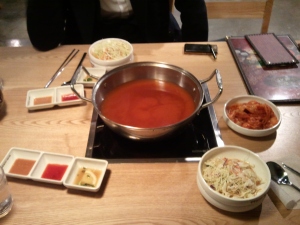
A large bowl with spicy broth is heated on the range, and dipping sauces and sides start being brought in droves.

Lots of vegetables and mushrooms are added to the spicy broth, and a basket of raw meat is left at the table.

Raw meat makes me salivate. Mmmm
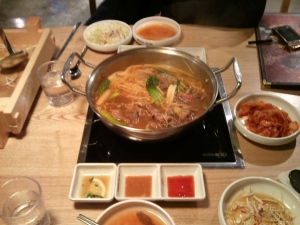
The completed dish. As the vegetables and beef cook in the soup, it changes the taste of the liquid dramatically. The goal of ShabuShabu is to finish all the vegetables and beef. Once you finish all the mix-ins, the waitress will bring you the noodles as a prize. Essentially, all the other food was just to turn the basic spicy water into a nutritious, dense broth to be eaten with noodles.
*Note: ShabuShabu is paired with kimchi. If a ShabuShabu restaurant has bad kimchi, it doesn’t matter how good their ShabuShabu is, no one will eat there.
Now that the historical sight-seeing was over with, we headed out to the popular markets of Jogno and Insadong. Jogno is set up like a large department store, but on the streets. Each section will have maybe 20 stores on each side of the road all selling the same things. There was a section for motorcycle stores, a section for hardware selling, etc. Insadong is popular for buying souvenirs, and many of its stores sell traditional Korean hand-made wares.
*Insadong pictures: My camera died so I have no pictures from Insadong or Nakwan Arcade. I will add them next time I visit!
Nearby Insadong was Nakwan Arcade. This complex houses hundreds of competing instrument stores. I wasn’t able to bring my guitar with me to Korea, so I tried to look for a cheap temporary one. Korean brands, such as Dexter, Dame, Cort, or O’Bang, were actually very well made and sounded rich for the low price. I’ll probably return there in a few days to make a purchase. Few items are priced, so haggling is key.
Nakwan Arcade was our last stop, and we grabbed a taxi home to Apgujeong-dong. My cousin took me to a great bar, Tomo (“friend”, in Japanese). We enjoyed a couple bottles of warm sake and many delicious appetizers to complement the alcohol. Dong Woo took the chance to teach me about Korean drinking culture:
- Your elder will serve you a drink first. Hold your glass with two hands to receive the alcohol.
- Pour alcohol for you elder, using your right hand to pour and your left to support your right.
- Unless you are drinking a “slow” drink, down the first drink like a shot.
- If your elder’s drink is lower than half-full, fill it for him.
- Never pour your own drink.
- Koreans enjoy 1,2,3. This means you have 3 different types of alcohol in 3 different places. For example, you will visit a chicken and beer bar first, then maybe a whiskey bar, and then maybe end the night with some sake.
Well that’s all for yesterday. I’ll be filling in those asterisks with some pictures once I sort through the multitude. See you soon!
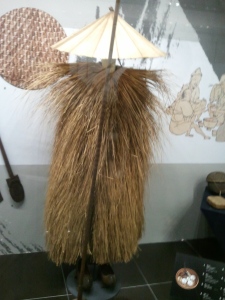
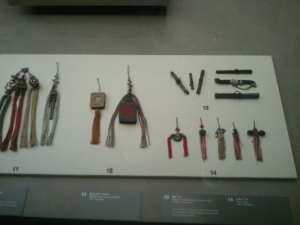
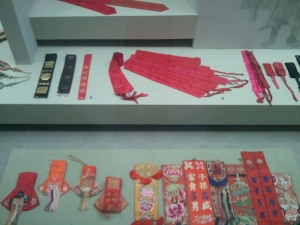

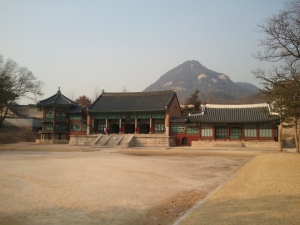
Leave a comment